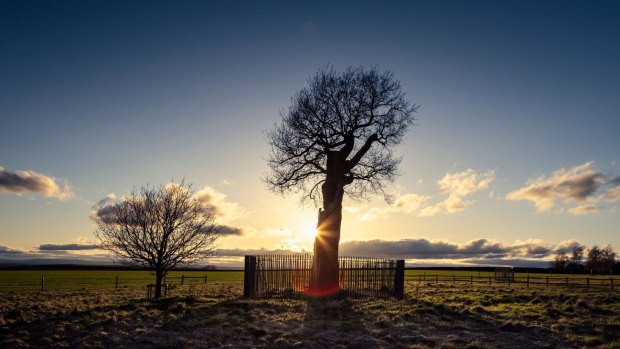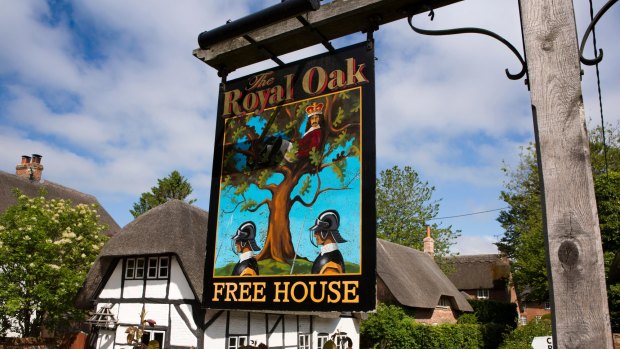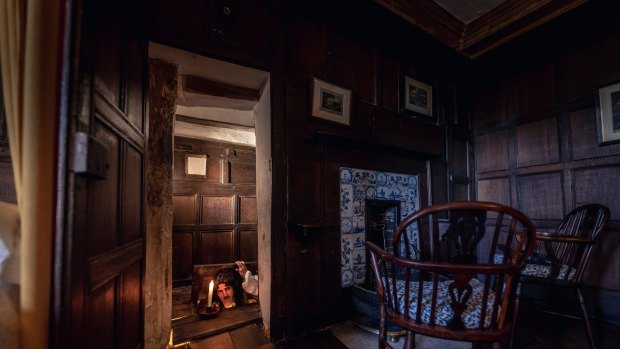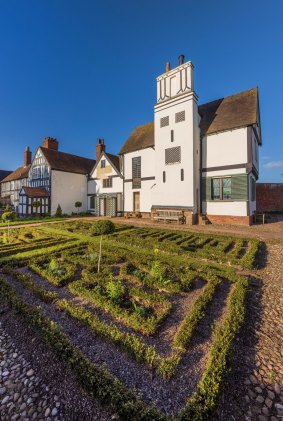This was published 2 years ago
Royal Oak tree, Boscobel House, England: Why so many pubs are called 'The Royal Oak'
By David Whitley

The current Royal Oak at Boscobel House, where Charles II was said to have hidden from pursuers in 1651.Credit: Christopher Ison
The Royal Oak feels like it should be several degrees more magnificent. This is one of the most famous trees in England. Hundreds of pubs are named after it, including at least a dozen in Australia. Yet it stands alone, aged-wearied and apologetic, almost as if it has lost function in one side.
The tale of the Royal Oak was once a staple that everyone in Britain knew. It was taught in schools, frequently regurgitated in the media and part of the national narrative. And the tale of a king who escaped by hiding up a tree is undeniably a cracker, even if it has fallen out of the collective consciousness.
The Royal Oak is outside Boscobel House in Staffordshire, just north of Birmingham. Boscobel was where King Charles II found refuge after a disastrous defeat at the Battle of Worcester in 1651. It marked the end of the English Civil War, with the parliamentarians victorious and royalists finally beaten.

A sign for a Royal Oak pub in Wiltshire, England illustrates the story behind the name. Credit: Alamy
Charles II's father, Charles I, had already been beheaded for treason. A similar fate awaited the defeated king, who turned from the battlefield at Worcester and fled. He tried to make it over the border into Wales, but found all the bridges over the River Severn blocked by enemy guards.
Boscobel House had been recommended as a potential place of refuge by the Earl of Derby, who had stayed there on the way to Worcester. The house was owned by the Giffard family, quiet Catholics in a time where Catholics were heavily discriminated against and often persecuted.
The runaway king was accompanied by the Penderel brothers, who lived on the estate. They managed to get him to the property without being seen, but Parliamentarian soldiers were scouring the grounds. The safest place for the king, until the scouts had moved on, was up a tree. He later stayed the night at Boscobel, before being spirited away to France via an extraordinary network of safe houses.

The priest hole at Boscobel House.Credit: Christopher Ison
If he'd attempted such a wheeze today, Charles II would have his head under the axe pretty darned quickly. The Royal Oak is out on its own, but back in 1651, it was part of a fairly thick woodland. What happened since is a classic tale of tourism overkill.
Once Charles II was restored to the throne in 1660, and the story of the Royal Oak became part of the national psyche, tourists started flocking to Boscobel. The woods were cleared, offering better views of the famous tree. And then souvenir-hunters set about the Royal Oak with such gusto that it was destroyed.
The current Royal Oak is not the original. It is billed as a 'descendant'. And another descendant is slowly growing next to it, for when the present incumbent loses its battle against the elements.

Boscobel House in Shropshire where King Charles II famously hid in an oak while being pursued by Oliver Cromwell's soldiers following defeat at Worcester. Credit: Christopher Ison
The site is now managed by English Heritage, which has recently planted a series of saplings in the field. Over time, the Royal Oak will be surrounded again. Not as thickly as it was in King Charles II's day, but it will at least look like an approximation of a woodland.
Until then, the atmospherics come inside Boscobel House itself. The house is open to the public, and uses a bit of gimmickry to tell the tale of Charles II's escape. Everyone is given a fake candle to hold, which they can put down on strategically placed books as they go round. This kicks sound and light shows into life. In one room you might hear a hungry Charles II cooking up a lamb chop, in another there might be a video in the mirror of him cutting his hair off.
It's all bonus frippery, though. The bit that's truly interesting is the priest hole on the top level. This is roughly wardrobe-sized, and built into the floor. Back in the 17th century, many Catholic households had a priest hole. They were designed to hide a priest, should the authorities be chasing them down. And, in 1651, the priest hole got used for a king instead.
King Charles II spent the night inside the claustrophobic hideaway. It can't have been much more comfortable than sitting outside in the tree, and the sense of romantic derring-do is stripped away in favour of pitiable concealment. You never see a pub called 'The Royal Priest Hole', after all.
TRIP NOTES
VISIT
Entry to Boscobel House, including the Royal Oak, costs £10. See english-heritage.org.uk
MORE
Disclosure: David Whitley was a guest of English Heritage.
See also: The six designs for Sydney Harbour Bridge that didn't make the cut
Sign up for the Traveller Deals newsletter
Get exclusive travel deals delivered straight to your inbox. Sign up now.